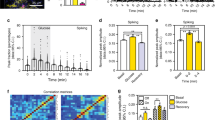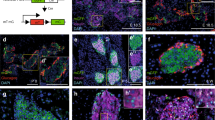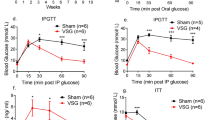Abstract
Pancreatic β-cells form highly connected networks within isolated islets. Whether this behaviour pertains to the situation in vivo, after innervation and during continuous perfusion with blood, is unclear. In the present study, we used the recombinant Ca2+ sensor GCaMP6 to assess glucose-regulated connectivity in living zebrafish Danio rerio, and in murine or human islets transplanted into the anterior eye chamber. In each setting, Ca2+ waves emanated from temporally defined leader β-cells, and three-dimensional connectivity across the islet increased with glucose stimulation. Photoablation of zebrafish leader cells disrupted pan-islet signalling, identifying these as likely pacemakers. Correspondingly, in engrafted mouse islets, connectivity was sustained during prolonged glucose exposure, and super-connected ‘hub’ cells were identified. Granger causality analysis revealed a controlling role for temporally defined leaders, and transcriptomic analyses revealed a discrete hub cell fingerprint. We thus define a population of regulatory β-cells within coordinated islet networks in vivo. This population may drive Ca2+ dynamics and pulsatile insulin secretion.
This is a preview of subscription content, access via your institution
Access options
Access Nature and 54 other Nature Portfolio journals
Get Nature+, our best-value online-access subscription
$29.99 / 30 days
cancel any time
Subscribe to this journal
Receive 12 digital issues and online access to articles
$119.00 per year
only $9.92 per issue
Buy this article
- Purchase on Springer Link
- Instant access to full article PDF
Prices may be subject to local taxes which are calculated during checkout






Similar content being viewed by others
Data availability
The data that support the findings of this study and the MATLAB codes for the various connectivity analyses described above are available from the corresponding authors upon request. Zebrafish islet RNA-seq data are deposited at the Gene Expression Omnibus repository with accession no. GSE123662.
References
DeFronzo, R. A., Ferrannini, E., Zimmet, P. & Alberti, G. International Textbook of Diabetes Mellitus 4th edn (Wiley-Blackwell, 2015).
Rutter, G. A., Pullen, T. J., Hodson, D. J. & Martinez-Sanchez, A. Pancreatic beta cell identity, glucose sensing and the control of insulin secretion. Biochem. J. 466, 202–218 (2015).
Tarasov, A. I. et al. The mitochondrial Ca2+ uniporter MCU is essential for glucose-induced ATP increases in pancreatic β-cells. PLoS ONE 7, e39722 (2012).
Xin, Y. et al. RNA sequencing of single human islet cells reveals type 2 diabetes genes. Cell Metab. 24, 608–615 (2016).
Segerstolpe, A. et al. Single-cell transcriptome profiling of human pancreatic islets in health and type 2 diabetes. Cell Metab. 24, 593–607 (2016).
Li, J. et al. Single-cell transcriptomes reveal characteristic features of human pancreatic islet cell types. EMBO Rep. 17, 178–187 (2016).
Wang, Y. J. et al. Single-cell transcriptomics of the human endocrine pancreas. Diabetes 65, 3028–3038 (2016).
Kiekens, R. et al. Differences in glucose recognition by individual rat pancreatic B cells are associated with intercellular differences in glucose-induced biosynthetic activity. J. Clin. Invest. 89, 117–125 (1992).
Ammala, C. et al. Inositol trisphosphate-dependent periodic activation of a Ca2+-activated K+ conductance in glucose-stimulated pancreatic β-cells. Nature 353, 849–852 (1991).
Benninger, R. K. & Piston, D. W. Cellular communication and heterogeneity in pancreatic islet insulin secretion dynamics. Trends Endocrinol. Metab. 25, 399–406 (2014).
Meda, P. et al. The topography of electrical synchrony among beta-cells in the mouse islet of Langerhans. Q. J. Exp. Physiol. 69, 719–735 (1984).
Palti, Y., David, G. B., Lachov, E., Mida, Y. H. & Schatzberger, R. Islets of Langerhans generate wavelike electric activity modulated by glucose concentration. Diabetes 45, 595–601 (1996).
Benninger, R. K., Zhang, M., Head, W. S., Satin, L. S. & Piston, D. W. Gap junction coupling and calcium waves in the pancreatic islet. Biophys. J. 95, 5048–5061 (2008).
Head, W. S. et al. Connexin-36 gap junctions regulate in vivo first- and second-phase insulin secretion dynamics and glucose tolerance in the conscious mouse. Diabetes 61, 1700–1707 (2012).
Meda, P., Kohen, E., Kohen, C., Rabinovitch, A. & Orci, L. Direct communication of homologous and heterologous endocrine islet cells in culture. J. Cell Biol. 92, 221–226 (1982).
Meda, P., Santos, R. M. & Atwater, I. Direct identification of electrophysiologically monitored cells within intact mouse islets of Langerhans. Diabetes 35, 232–236 (1986).
Rutter, G. A. & Hodson, D. J. Beta cell connectivity in pancreatic islets: a type 2 diabetes target? Cell Mol. Life Sci. 72, 453–467 (2015).
Hodson, D. J. et al. Lipotoxicity disrupts incretin-regulated human beta cell connectivity. J. Clin. Invest. 123, 4182–4194 (2013).
Stozer, A. et al. Functional connectivity in islets of Langerhans from mouse pancreas tissue slices. PLoS Comput. Biol. 9, e1002923 (2013).
Hodson, D. J. et al. Existence of long-lasting experience-dependent plasticity in endocrine cell networks. Nat. Commun. 3, 605 (2012).
Johnston, N. R. et al. Beta cell hubs dictate pancreatic islet responses to glucose. Cell Metab. 24, 389–401 (2016).
Speier, S. et al. Noninvasive in vivo imaging of pancreatic islet cell biology. Nat. Med. 14, 574–578 (2008).
Tian, L. et al. Imaging neural activity in worms, flies and mice with improved GCaMP calcium indicators. Nat. Methods 6, 875–881 (2009).
van der Meulen, T. et al. Virgin beta cells persist throughout life at a neogenic niche within pancreatic islets. Cell Metab. 25, 911–926 (2017).
Chen, C. et al. Alterations in beta-cell calcium dynamics and efficacy outweigh islet mass adaptation in compensation of insulin resistance and prediabetes onset. Diabetes. 65, 2676–2685 (2016).
Singh, S. P. et al. Different developmental histories of beta-cells generate functional and proliferative heterogeneity during islet growth. Nat. Commun. 8, 664–00461 (2017).
Kimmel, R. A. & Meyer, D. Zebrafish pancreas as a model for development and disease. Methods Cell Biol. 134, 431–461 (2016).
Steiner, D. J., Kim, A., Miller, K. & Hara, M. Pancreatic islet plasticity: interspecies comparison of islet architecture and composition. Islets 2, 135–145 (2010).
Bosco, D. et al. Unique arrangement of alpha- and beta-cells in human islets of Langerhans. Diabetes 59, 1202–1210 (2010).
Prince, V. E., Anderson, R. M. & Dalgin, G. Zebrafish pancreas development and regeneration: fishing for diabetes therapies. Curr. Top. Dev. Biol. 124, 235–276 (2017).
Ninov, N. et al. Metabolic regulation of cellular plasticity in the pancreas. Curr. Biol. 23, 1242–1250 (2013).
Granger, C. W. J. Investigating causal relations by econometric models and cross-spectral methods. Econometrica 37, 424–438 (1969).
Barnett, L. & Seth, A. K. The MVGC multivariate Granger causality toolbox: a new approach to Granger-causal inference. J. Neurosci. Methods 223, 50–68 (2014).
Janjuha, S., Pal, S. S. & Ninov, N. Analysis of beta-cell function using single-cell resolution calcium imaging in zebrafish islets. J. Vis. Exp. 10, e57851 (2018).
Gut, P. et al. Whole-organism screening for gluconeogenesis identifies activators of fasting metabolism. Nat. Chem. Biol. 9, 97–104 (2013).
Markovic, R. et al. Progressive glucose stimulation of islet beta cells reveals a transition from segregated to integrated modular functional connectivity patterns. Sci. Rep. 5, 7845 (2015).
Hesselson, D., Anderson, R. M., Beinat, M. & Stainier, D. Y. Distinct populations of quiescent and proliferative pancreatic beta-cells identified by HOTcre mediated labeling. Proc. Natl Acad. Sci. USA 106, 14896–14901 (2009).
Diraison, F. et al. Over-expression of sterol-regulatory-element-binding protein-1c (SREBP1c) in rat pancreatic islets induces lipogenesis and decreases glucose-stimulated insulin release: modulation by 5-aminoimidazole-4-carboxamide ribonucleoside (AICAR). Biochem. J. 378, 769–778 (2004).
Kone, M. et al. LKB1 and AMPK differentially regulate pancreatic beta-cell identity. FASEB J. 28, 4972–4985 (2014).
Thorens, B. et al. Ins1 knock-in mice for beta cell-specific gene recombination. Diabetologia 58, 558–656 (2015).
Rodriguez-Diaz, R. et al. Noninvasive in vivo model demonstrating the effects of autonomic innervation on pancreatic islet function. Proc. Natl Acad. Sci. USA 109, 21456–21461 (2012).
Ilegems, E. et al. Light scattering as an intrinsic indicator for pancreatic islet cell mass and secretion. Sci. Rep. 5, 10740 (2015).
Nyqvist, D. et al. Donor islet endothelial cells in pancreatic islet revascularization. Diabetes 60, 2571–2577 (2011).
Westacott, M. J., Ludin, N. W. F. & Benninger, R. K. P. Spatially organized beta-cell subpopulations control electrical dynamics across islets of Langerhans. Biophys. J. 113, 1093–1108 (2017).
Reinbothe, T. M., Safi, F., Axelsson, A. S., Mollet, I. G. & Rosengren, A. H. Optogenetic control of insulin secretion in intact pancreatic islets with beta-cell-specific expression of Channelrhodopsin-2. Islets 6, e28095 (2014).
Lorincz, R. et al. In vivo monitoring of intracellular Ca2+ dynamics in the p ancreatic beta-cells of zebrafish embryos. Islets 10, 221–238 (2018).
Gosak, M. et al. Critical and supercritical spatiotemporal calcium dynamics in beta cells. Front. Physiol. 8, 1106 (2017).
Ammala, C., Ashcroft, F. M. & Rorsman, P. Calcium-independent potentiation of insulin release by cyclic AMP in single beta-cells. Nature 363, 356–358 (1993).
Lu, T. T. et al. The polycomb-dependent epigenome controls beta cell dysfunction, dedifferentiation, and diabetes. Cell Metab. 27, 1294–1308 (2018).
Mullapudi, S. T. et al. Screening for insulin-independent pathways that modulate glucose homeostasis identifies androgen receptor antagonists. eLife 7, e42209 (2018).
Schindelin, J. et al. Fiji: an open-source platform for biological-image analysis. Nat. Methods 9, 676–682 (2012).
Ollion, J., Cochennec, J., Loll, F., Escude, C. & Boudier, T. TANGO: a generic tool for high-throughput 3D image analysis for studying nuclear organization. Bioinformatics 29, 1840–1841 (2013).
Preibisch, S., Saalfeld, S., Schindelin, J. & Tomancak, P. Software for bead-based registration of selective plane illumination microscopy data. Nat. Methods 7, 418–419 (2010).
Luo, J. et al. A protocol for rapid generation of recombinant adenoviruses using the AdEasy system. Nat. Protoc. 2, 1236–1247 (2007).
Ravier, M. A. & Rutter, G. A. Isolation and culture of mouse pancreatic islets for ex vivo imaging studies with trappable or recombinant fluorescent probes. Methods Mol. Biol. 633, 171–184 (2010).
Janjuha, S. et al. Age-related islet inflammation marks the proliferative decline of pancreatic beta-cells in zebrafish. eLife 7, 32965 (2018).
Zheng, G. X. et al. Massively parallel digital transcriptional profiling of single cells. Nat. Commun. 8, 14049 (2017).
Baron, M. et al. A single-cell transcriptomic map of the human and mouse pancreas reveals inter- and intra-cell population structure. Cell Syst. 3, 346–360 (2016).
Butler, A., Hoffman, P., Smibert, P., Papalexi, E. & Satija, R. Integrating single-cell transcriptomic data across different conditions, technologies, and species. Nat. Biotechnol. 36, 411–420 (2018).
Mi, H. et al. PANTHER version 11: expanded annotation data from Gene Ontology and Reactome pathways, and data analysis tool enhancements. Nucleic Acids Res. 45, D183–D189 (2017).
Acknowledgements
V.S. was supported by a Diabetes UK Harry Keen Clinician Scientist 15/0005317. G.A.R. was supported by a Wellcome Trust Senior Investigator Award (no. WT098424AIA), Wellcome Trust Investigator Award (212625/Z/18/Z), MRC Programme grants (nos. MR/R022259/1, MR/J0003042/1 and MR/L020149/1) and Experimental Challenge Grant (DIVA, no. MR/L02036X/1), MRC (no. MR/N00275X/1), Diabetes UK (nos. BDA/11/0004210, BDA/15/0005275 and BDA 16/0005485) and Imperial Confidence in Concept grants, and a Royal Society Wolfson Research Merit Award. I.L. was supported by Diabetes UK Project Grant no. 16/0005485 and D.J.H. by a Diabetes UK R.D. Lawrence Fellowship (no. 12/0004431), a Wellcome Trust Institutional Support Award, and Medical Research Council (no. MR/N00275X/1) and Diabetes UK (no. 17/0005681) Project Grants. N.N. received funding from the DFG–Center for Regenerative Therapies Dresden, Cluster of Excellence at TU Dresden and the German Center for Diabetes Research (DZD), as well as research grants from the German Research Foundation (DFG), the European Foundation for the Study of Diabetes, The International Research Training Group (IRTG 2251), and the DZD. L.J.B.B. was supported by a Sir Henry Wellcome Postdoctoral Fellowship (Wellcome Trust, no. 201325/Z/16/Z) and a Junior Research Fellowship from Trinity College, Oxford. This project has received funding from the European Research Council (under the European Union’s Horizon 2020 research and innovation programme (Starting Grant no. 715884 to D.J.H.) and from the Innovative Medicines Initiative 2 Joint Undertaking under grant agreement no. 115881 (RHAPSODY) to G.A.R. and P.M. This Joint Undertaking receives support from the European Union’s Horizon 2020 research and innovation programme and European Federation of Pharmaceutical Industries and Associations. We would like to thank P.-O. Berggren (Karolinska Institute, Sweden and Imperial College London), A. Caicedo and R. Rodriguez (University of Miami), and P. Chabosseau, M.-S. Nguyen-Tu and B. Owen (Imperial College London) for valuable advice and support with surgery and imaging. We thank R. Callingham (Imperial College London) for assistance with human islet culture.
Author information
Authors and Affiliations
Contributions
V.S., N.N. and G.A.R. designed and supervised the study. L.D.S. and N.A. performed the zebrafish experiments. V.S., K.S., A.M.A. and I.L. undertook the mouse studies. G.C. and K.S. performed virus preparations. D.C.A.G., S.M.R., K.S., L.D.S. and V.S. developed movement correction macros. E.G., S.N.M.G., N.A., T.S., D.J.H. and L.B. contributed to connectivity analysis. D.J.H. and L.B. provided the code for connectivity analysis. V.S. and W.D. developed connectivity and Granger scripts and undertook all connectivity analyses. P.M. and A.M.J.S. provided human islets. K.S. and V.S. undertook studies on these preparations. T.J.P., N.A. and S.P.S. performed transcriptomic and bioinformatics analyses. G.A.R., V.S., L.D.S. and N.N. wrote the manuscript with contributions from all authors.
Corresponding authors
Ethics declarations
Competing interests
G.A.R. has received grant funding from Servier and is a consultant for Sun Pharma. All others authors declare no competing interests.
Additional information
Peer review information: Primary Handling Editor: Elena Bellafante.
Publisher’s note: Springer Nature remains neutral with regard to jurisdictional claims in published maps and institutional affiliations.
Supplementary information
Supplementary Information
Supplementary Tables 1 and 2, and Supplementary Figures 1–6
Rights and permissions
About this article
Cite this article
Salem, V., Silva, L.D., Suba, K. et al. Leader β-cells coordinate Ca2+ dynamics across pancreatic islets in vivo. Nat Metab 1, 615–629 (2019). https://doi.org/10.1038/s42255-019-0075-2
Received:
Accepted:
Published:
Issue Date:
DOI: https://doi.org/10.1038/s42255-019-0075-2
This article is cited by
-
Readily releasable β cells with tight Ca2+–exocytosis coupling dictate biphasic glucose-stimulated insulin secretion
Nature Metabolism (2024)
-
Functionally heterogeneous β cells regulate biphasic insulin secretion
Nature Metabolism (2024)
-
Differential CpG methylation at Nnat in the early establishment of beta cell heterogeneity
Diabetologia (2024)
-
Single-nucleus RNA sequencing of human pancreatic islets identifies novel gene sets and distinguishes β-cell subpopulations with dynamic transcriptome profiles
Genome Medicine (2023)
-
Islet autoimmunity in human type 1 diabetes: initiation and progression from the perspective of the beta cell
Diabetologia (2023)



